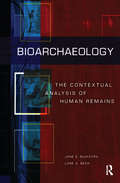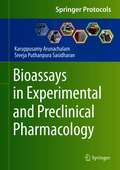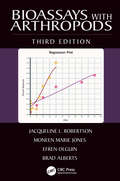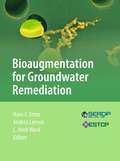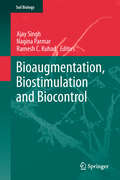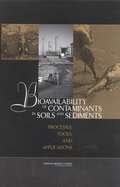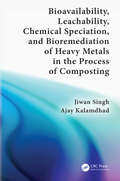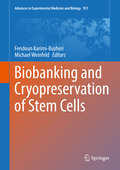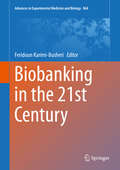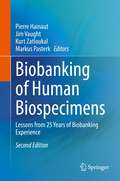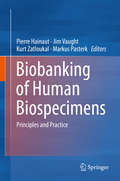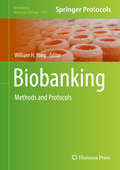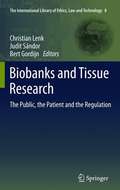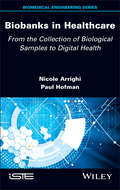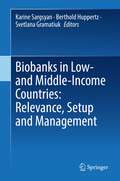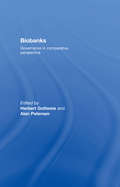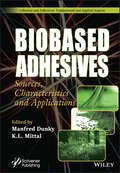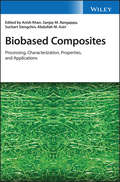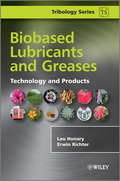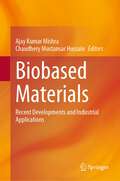- Table View
- List View
Bioarchaeology: The Contextual Analysis of Human Remains (Bioarchaeology And Social Theory Ser.)
by Jane E. Buikstra Lane A. BeckThe core subject matter of bioarchaeology is the lives of past peoples, interpreted anthropologically. Human remains, contextualized archaeologically and historically, form the unit of study. Integrative and frequently inter-disciplinary, bioarchaeology draws methods and theoretical perspectives from across the sciences and the humanities. Bioarchaeology: The Contextual Study of Human Remains focuses upon the contemporary practice of bioarchaeology in North American contexts, its accomplishments and challenges. Appendixes, a glossary and 150 page bibliography make the volume extremely useful for research and teaching.
Bioassay Techniques for Drug Development
by Atta-ur-Rahman M. Iqbal Choudhary William J. ThomsenThe goal of an activity-directed isolation process is to isolate bioactive compounds which may provide structural leads of therapeutic importance. Whereas the traditional process of drug development is long and expensive, simple and rapid bioassays can serve as the starting point for drug discovery. This book presents a range of "bench top" bioassa
Bioassays in Experimental and Preclinical Pharmacology (Springer Protocols Handbooks)
by Karuppusamy Arunachalam Sreeja Puthanpura SasidharanThis detailed book explores protocols for a wide array of preclinical pharmacology and toxicology evaluations to be applied to chemical drugs and their development through in vitro, involving tissues and cell lines, and in vivo models, using animals as experimental systems, utilized to conduct pharmacological research. Written for the Springer Protocols Handbooks series, the methodologies included in this collection have been standardized by the authors through extensive use in the lab so that they are ready to be applied in the labs of readers around the world. Authoritative and practical, Bioassays in Experimental and Preclinical Pharmacology aims to assist undergraduate and postgraduate students, research scholars, scientists, and other academicians performing research in the vital field of drug discovery.
Bioassays with Arthropods
by Efren Olguin Brad Alberts Jacqueline Robertson Moneen JonesImagine a statistics book for bioassays written by a statistician. Next, imagine a statistics book for bioassays written for a layman. Bioassays with Arthropods, Third Edition offers the best of both worlds by translating the terse, precise language of the statistician into language used by the laboratory scientist. The book explains the statistical basis and analysis for each kind of quantal response bioassay in just the right amount of detail. The first two editions were a great reference for designing, conducting, and interpreting bioassays: this completely revised and updated third edition will also train the laboratory scientist to be an expert in estimation of dose response curves. New in the Third Edition: Introduces four new Windows and Apple-based computer programs (PoloJR, OptiDose, PoloMixture and PoloMulti) for the analyses of binary and multiple response analyses, respectively Replaces out-of-date GLIM examples with R program samples Includes a new chapter, Population Toxicology, and takes a systems approach to bioassays Expands the coverage of invasive species and quarantine statistics Building on the foundation set by the much-cited first two editions, the authors clearly delineate applications and ideas that are exceptionally challenging for those not already familiar with their use. They lead you through the methods with such ease and organization, that you suddenly find yourself readily able to apply concepts that you never thought you would understand. To order the PoloSuite computer software described in Bioassays with Arthropods, Third Edition, use the order form found at www.leora-software.com or contact the LeOra Software Company at leorasoftware@gmail.com.
Bioaugmentation Techniques and Applications in Remediation
by InamuddinIt has been observed that rapid population expansion has raised the amount of anthropogenic activity, resulting in high levels of pollution in water, air, and solid waste as well as an increase in the pressure placed on agricultural lands. Bioaugmentation Techniques and Applications in Remediation provides detailed information on bioaugmentation approaches for the remediation of sediments, water, and soil polluted with organic and inorganic pollutants. Practical applications of bioaugmentation techniques performed in restricted systems under controlled conditions, laboratory investigations, and in the field are addressed. Special emphasis is placed on the applications of nanomaterials in combination with bioaugmentation techniques for enhanced bioremediation efficiency. FEATURES Explores abiotic and biotic factors that enhance and facilitate environmental remediation of contaminants Provides a primer on the elementary microbial processes entailed in bioaugmentation Summarizes methods and approaches for executing bioaugmentation technology Details commercially available products and instrumentation This book is an ideal resource for researchers, students, and engineers working in materials science and bioremediation.
Bioaugmentation for Groundwater Remediation (SERDP ESTCP Environmental Remediation Technology #5)
by C. Herb Ward Hans F. Stroo Andrea LeesonThis volume provides a review of the past 10 to 15 years of intensive research, development and demonstrations that have been on the forefront of developing bioaugmentation into a viable remedial technology. This volume provides both a primer on the basic microbial processes involved in bioaugmentation, as well as a thorough summary of the methodology for implementing the technology. This reference volume will serve as a valuable resource for environmental remediation professionals who seek to understand, evaluate, and implement bioaugmentation.
Bioaugmentation, Biostimulation and Biocontrol (Soil Biology #10)
by Ajay Singh Ramesh C. Kuhad Nagina ParmarBioaugmentation, biostimulation and biocontrol approaches using microbial inoculants, biofertilizers, biochemicals and organic amendments improve soil biology, fertility and crop productivity by providing plant growth-promoting nutrients and suppressing soil-borne diseases and plant-parasitic nematodes. Our knowledge of microbial diversity and its function in soils has been increased tremendously due to the availability of a wealth of data gained through recent advances in the development of molecular methods and metagenomics for the evaluation of microbial diversity and functions in the rhizosphere environment of soil. Chapters dealing with the application of biofertilizers and organic amendments are contributed by experts - authorities in the area of soil science including microbiology and molecular biology - from academic institutions and the industry.
Bioavailability Of Contaminants In Soils And Sediments: Processes, Tools, And Applications
by Committee on Bioavailability of Contaminants in Soils SedimentsBioavailability refers to the extent to which humans and ecological receptors are exposed to contaminants in soil or sediment. The concept of bioavailability has recently piqued the interest of the hazardous waste industry as an important consideration in deciding how much waste to clean up. The rationale is that if contaminants in soil and sediment are not bioavailable, then more contaminant mass can be left in place without creating additional risk. A new NRC report notes that the potential for the consideration of bioavailability to influence decision-making is greatest where certain chemical, environmental, and regulatory factors align. The current use of bioavailability in risk assessment and hazardous waste cleanup regulations is demystified, and acceptable tools and models for bioavailability assessment are discussed and ranked according to seven criteria. Finally, the intimate link between bioavailability and bioremediation is explored. The report concludes with suggestions for moving bioavailability forward in the regulatory arena for both soil and sediment cleanup.
Bioavailability of Organic Chemicals in Soil and Sediment (The Handbook of Environmental Chemistry #100)
by Jose Julio Ortega-Calvo John Robert ParsonsThis book discusses bioavailability concepts and methods, summarizing the current knowledge on bioavailability science, as well as possible pathways for integrating bioavailability into risk assessment and the regulation of organic chemicals. Divided into 5 parts, it begins with an overview of chemical distribution in soil and sediment, as well as the bioavailability and bioaccumulation of chemicals in plants, soil, invertebrates and vertebrates (including humans). It then focuses on the impact of sorption processes and reviews bioavailability measurement methods. The closing chapters discuss the impact of bioavailability studies on chemical risk assessment, and highlights further research needs. Written by a multi-disciplinary team of authors, it is an essential resource for scientists in academia and industry, students, as well as for authorities.
Bioavailability, Leachability, Chemical Speciation, and Bioremediation of Heavy Metals in the Process of Composting
by Jiwan Singh Ajay KalamdhadCurrently, it is a serious concern to manage waste in the environment. Therefore, detailed knowledge of heavy metals, their eco-toxicological and health effects and ecofriendly approaches for their immobilization and detoxification is urgently required to control and minimize the environmental pollution. Composting is one of the popular methods in waste management and there are a lot of issues pertaining to composting. One of it is the leaching of heavy metals. This book discusses thoroughly, the availability, leachability and the speciation of heavy metals in the entire process of composting.
Bioavailability: Physical, Chemical, and Biological Interactions
by William H. Benson Jerry Hamelink Peter F. Landrum Harold BergmanPractical and provocative, Bioavailability reviews prevalent understanding of the physical-chemical-biological mechanisms that control the bioavailability of both organic and inorganic contaminants in aquatic environments.Discusses the complex issues that surround many regulatory issues Emphasizes the need to identify and control that portion of the total concentration that is biologically available and can cause adverse effects, i.e., "active" Examines the influence of dynamic factors, such as pH, alkalinity, and light on these mechanisms Addresses the subject of speciation for both organic and inorganic contaminants
Biobanking and Cryopreservation of Stem Cells (Advances in Experimental Medicine and Biology #951)
by Feridoun Karimi-Busheri Michael WeinfeldBiobanking is considered to be one of the ten ideas changing the world with an estimated value of $45 billion by 2025. Despite the challenges, as the climate for innovation in the biobanking industry continues to flourish around the world, it is certain that amazing discoveries will emerge from this large-scale method of preserving and accessing human samples; biobanking is no longer just a place for collecting and storing samples. This book will cover a wide variety of subjects from across the future biobanking spectrum including scientific strategies, personalized medicine, regenerative medicine and stem cell challenges, disease surveillance, population genetics and innovative methods of biobanking.
Biobanking in the 21st Century: Volume I - Techniques (Advances in Experimental Medicine and Biology #864)
by Feridoun Karimi-BusheriBiobanking, an emerging field supported by academia, industry and health administrators alike, is distinctly different today from the practice that once defined it. The science of Biobanking, which initially involved simply storing blood or tissue samples in a freezer, is now a highly sophisticated field of research, and expected to grow exponentially over the next decade or two. This book aims to serve the purpose of further enriching the available literature on Biobanking, by offering unique and more useful collection of ideas for the future. The book outlines the experiences of developing modern Biobanking repositories in different countries, whilst covering specific topics regarding the many aspects of Biobanking. This book will be of interest to a wide range of readers including: academics, students, volunteers and advocates of patients' rights.
Biobanking of Human Biospecimens: Lessons from 25 Years of Biobanking Experience
by Pierre Hainaut Jim Vaught Kurt Zatloukal Markus PasterkOver the past 25 years, biobanks of human specimens have become a cornerstone for research on human health and have empowered the “omics “revolution that characterizes biomedical science in the XXIst Century. Today, biobanking of human specimens is a critical component of the interface between clinical practice and translational research, supporting the discovery and validation of new biomarkers of disease etiology, risk, early detection, diagnosis, prognosis, prediction and relapse. With the development of personalized medicine, biobanking of cryopreserved specimens has become standard practice in order to investigate genetic, transcriptomic, proteomic, metabolomics and immunological biomarkers useful to inform caregivers for therapeutic decisions. Data generated from biobanked specimens represent a rapidly growing and highly valuable resource, participating in the emergence of Big Data Medicine. With the development of large computing capabilities and artificial intelligence, data associated with biobanked specimens constitute a unique resource for the discovery and validation of new biomarkers and therapeutically actionable targets. Interconnecting, interoperating and sharing this data have become major issues for national health systems, raising enormous stakes as well as major societal, legal and cybersecurity challenges in terms of compliance with the protection of personal sensitive information. This book project is the second part of an initiative launched in 2012 to produce a published corpus of knowledge encompassing all aspects of human biobanking as a central practice for research and medicine. The first volume, published in 2017, is entitled: Human Biobanking: Principles and Practice. This first volume compiled a series of high level contributions overseeing the main developments that carried the progression of human biobanking as a research and biotechnological field over the past two decades. This new book project will constitute de facto Volume 2 of the same initiative, under the title: Biobanking of Human Biospecimens: lessons from 25 years of biobanking experience. Hence, the two volumes will share the same generic title (Biobanking of Human Biospecimens), with different subtitles, making clear that the two volumes are interrelated while highlighting their specificities in terms of what they actually cover. As a result, the two books are “twins” but can also be used independently of each other.The overarching aim of the two volumes of Biobanking of Human Biospecimens is to provide a published “one-stop shop” for state-of-the-art information on what constitutes the field of human biobanking, from conception of a biobank, standard operating procedures, ethical and societal aspects, governance, networking, interoperability and economic sustainability. This inclusive publication concept meets the needs of a vast readership, including scientists, doctors and technical staffs who are directly involved in biobanking operations, scientists in other disciplines that heavily rely on biobanking (such as genomics or proteomics), stakeholders and policy makers, and of course students for whom biobanking is becoming an important part of the training curriculum. So far, there has been a lack of major textbooks on biobanking. Documentation for biobanking is widely available through numerous publications, regulatory documents published by International or Governmental Agencies, and sets of recommendations essentially accessible through the Internet. However, it is difficult to access a single, top-of-the shelf reference that provides at a glance a large coverage of all aspects of human biobanking. Fulfilling this need is the main origin of the concept for this back-to-back publication project. To our knowledge, there is currently no other publication project with the same breath and scope as this one in the field of biobanking.
Biobanking of Human Biospecimens: Principles and Practice
by Pierre Hainaut Jim Vaught Kurt Zatloukal Markus PasterkThis volume is the first comprehensive text on human biobanking, authored by scientists and regulatory officers who have led the field over the past 10 years. It covers biobanking issues and its importance in advancing the field of research in cancer, cardiovascular, metabolic, and other diseases. Biobanks of human specimens have become the cornerstone for research on human health that harnesses the power of "omics" technologies to identify biomarkers for disease susceptibility. Biobanks are an essential component of the development of personalized medicine, which relies on the molecular analysis of biospecimens that are truly representative of individuals and of diseases. Over the past decade, biobanking has been the focus of major investments and developments aimed at developing appropriate infrastructure, methods, networking practice and evidence-based pre-analytical procedures. This volume explores topics including specimen storage, protocol design, specimen collection, pre-analytical processing and preservation, long-term storage, retrieval and separation, and distribution to analytical laboratory platforms. These activities are extremely complex and are essential for biomedical and biotechnological developments and this text provides critical information about biobanking for the development of future forms of medicine.
Biobanking: Methods And Protocols (Methods in Molecular Biology #1897)
by William H. YongThis volume not only discusses various common biobanking topics, it also delves into less-discussed subjects such as what is needed to start a biobank, training of new biobanking personnel, and ethnic representation in biospecimen research. Other chapters in this book span practical topics including: disaster prevention and recovery; information technology; flora and fauna preservation including zoological fluid specimen photography; surgical and autopsy biobanking; biobanking of bodily fluids; biosafety; cutting frozen sections; immunohistochemistry; nucleic acid extraction; and biospecimen shipping. Written in the highly successful Methods in Molecular Biology series format, chapters include introductions to their respective topics, lists of the necessary materials and reagents, step-by-step, readily reproducible laboratory protocols, and tips on troubleshooting and avoiding known pitfalls.Unique and comprehensive, Biobanking: Methods and Protocols is a valuable resource for novice and practicing biobankers, and for end-user researchers. This book aims to bring new insight into the field and expand on current biomedical biobanking studies.
Biobanks and Tissue Research: The Public, the Patient and the Regulation (The International Library of Ethics, Law and Technology #8)
by Bert Gordijn Judit Sándor Christian LenkThe research field of biobanks and tissue research is highly promising. Many projects around the globe are involved in the collection of human tissue and health data for research purposes. These initiatives are driven by the perspective of decisive breakthroughs in the knowledge of the genetic pathways involved in widespread diseases. However, there are considerable ethical and legal challenges to be considered as well. These challenges encompass the use of body material for research purposes, the misuse of genetic and other health data by third parties, trust in science and medicine, concerns regarding privacy, use of genetic data for forensic applications by the state and the police, and regulatory issues. This volume is divided into three parts: the inclusion of the public, the rights of donors and patients, examples and recommendations for the future of tissue research. It presents a comprehensive overview of the most important topics in the field by renowned scholars in medical ethics and biolaw.
Biobanks in Healthcare: From the Collection of Biological Samples to Digital Health (ISTE Invoiced)
by Paul Hofman Nicole ArrighiBiobanks ensuring the governance and management of biological resources have become essential entities. The development of biotechnologies, the increased prevalence of biological drugs and the identification of biomarkers associated with molecular classifications of tissue lesions make it essential to have organized access to human biological samples, which have become precious and rare. The digital era and the production of massive data that comes with it have rendered biobanks the guarantors of the reproducibility of experiments and of the overall quality of medical research. Biobanks in Healthcare explores the upheaval linked to the massive deployment of digital health and precision medicine. The future of health biology lies in the deployment of biobanks in fields that have yet to be explored, putting them at the forefront of this extraordinary 21st-century research adventure.
Biobanks in Low- and Middle-Income Countries: Relevance, Setup and Management
by Berthold Huppertz Karine Sargsyan Svetlana GramatiukThis book introduces the fundamentals of biobanking and guides through the practical planning thereof, with a special focus on the situation in low- and middle-income countries. On the example of the setup of a Ukrainian biobank the book discusses the main steps and aspects of successful biorepository implementation and management. Topics covered include collection, storage and shipping of samples, establishment of an IT system, development of a sustainability plan, and project and risk management. Furthermore, the importance of the formation of international biobanking societies such as the Ukraine Association of Biobanks is highlighted, and their main objectives and tasks are discussed.The book addresses life science and business professionals as well as national authorities who are interested in biobanking in general and in setting up a biobank in particular.
Biobanks: Governance in Comparative Perspective
by Alan Petersen Herbert GottweisIn recent years, a number of large population-based biobanks - genetic databases that combine genetic information derived from blood samples with personal data about environment, medical history, lifestyle or genealogy - have been set up in order to study the interface between disease, and genetic and environmental factors. Unsurprisingly, these studies have sparked a good deal of controversy and the ethical and social implications have been widely debated. Biobanks: Governance in Comparative Perspective is the first book to explore the political and governance implications of biobanks in Europe, the United States, Asia, and Australia. This book explores: the interrelated conditions needed for a biobank to be created and to exist the rise of the new bio-economy the redefinition of citizenship accompanying national biobank developments This groundbreaking book makes clear that biobanks are a phenomenon that cannot be disconnected from considerations of power, politics, and the reshaping of current practices in governance. It will be a valuable read for scholars and students of genetics, bioethics, risk, public health and the sociology of health and illness.
Biobased Adhesives: Sources, Characteristics, and Applications (Adhesion and Adhesives: Fundamental and Applied Aspects)
by K. L. Mittal Manfred DunkyBiobased Adhesives Unique and comprehensive book edited by acknowledged leaders on biobased adhesives that will replace petroleum-based adhesives. This book contains 23 chapters covering the various ramifications of biobased adhesives. The chapters are written by world-class scientists and technologists actively involved in the arena of biobased adhesives. The book is divided into three parts: Part 1: Fundamental Aspects; Part 2: Classes of Biobased Adhesives; and Part 3: Applications of Biobased Adhesives. Topics covered include: an introduction to biobased adhesives; adhesion theories and adhesion and surface issues with biobased adhesives; chemistry of adhesives; biorefinery products as biobased raw materials for adhesives; naturally aldehyde-based thermosetting resins; natural crosslinkers; curing and adhesive bond strength development in biobased adhesives; mimicking nature; bio-inspired adhesives; protein adhesives; carbohydrates as adhesives; natural polymer-based adhesives; epoxy adhesives from natural materials; biobased polyurethane adhesives; nanocellulose-modified adhesives; debondable, recyclable, and biodegradable biobased adhesives; 5-Hydroxymethylfurfural-based adhesives; adhesive precursors from tree-derived naval stores; and applications in various diverse arenas such as wood bonding, controlled drug delivery, and wearable bioelectronics. Audience This book will interest materials scientists, adhesionists, polymer chemists, marine biologists, food and agriculture scientists, and environmentalists. R&D personnel in a slew of wide-ranging industries such as aviation, shipbuilding, railway, automotive, packaging, construction, wood bonding, and composites should find this book a repository of current and much-needed information.
Biobased Composites: Processing, Characterization, Properties, and Applications
by Abdullah M. Asiri Anish Khan Suchart Siengchin Sanjay M. RangappaExplore the world of biocomposites with this one-stop resource edited by four international leaders in the field Biobased Composites: Processing, Characterization, Properties, and Applications delivers a comprehensive treatment of all known characterization methods, properties, and industry applications of biobased composites materials. This unique, one-stop resource covers all major developments in the field from the last decade of research into this environmentally beneficial area. The internationally recognized editors have selected resources that represent advances in the mechanical, thermal, tribological, and water sorption properties of biobased composites, and cover new areas of research in physico-chemical analysis, flame retardancy, failure mechanisms, lifecycle assessment, and modeling of biobased composites. The low weight, low cost, excellent thermal recyclability, and biodegradability of biobased composites make them ideal candidates to replace engineered plastic products derived from fossil fuel. This book provides its readers with the knowledge they'll require to understand a new class of materials increasingly being used in the automotive and packaging industries, aerospace, the military, and construction. It also includes: An extended discussion of the environmental impact of biobased composites using a life cycle methodology A review of forecasts of natural fiber reinforced polymeric composites and its degradability concerns An analysis of the physical and mechanical properties of a biobased composite with sisal powder A comprehensive treatment of the mechanical, thermal, tribological, and dielectric properties of biobased composites A review of processing methods for the manufacture of biobased composites Perfect for materials scientists in private industry, government laboratories, or engaged in academic research, Biobased Composites will also earn a place in the libraries of industrial and manufacturing engineers who seek a better understanding of the beneficial industrial applications of biocomposites in industries ranging from automobiles to packaging.
Biobased Industrial Products: Priorities for Research and Commercialization
by National Research CouncilPetroleum-based industrial products have gradually replaced products derived from biological materials. However, biologically based products are making a comeback--because of a threefold increase in farm productivity and new technologies.Biobased Industrial Products envisions a biobased industrial future, where starch will be used to make biopolymers and vegetable oils will become a routine component in lubricants and detergents.Biobased Industrial Products overviews the U.S. land resources available for agricultural production, summarizes plant materials currently produced, and describes prospects for increasing varieties and yields.The committee discusses the concept of the biorefinery and outlines proven and potential thermal, mechanical, and chemical technologies for conversion of natural resources to industrial applications.The committee also illustrates the developmental dynamics of biobased products through existing examples, as well as products still on the drawing board, and it identifies priorities for research and development.
Biobased Lubricants and Greases
by Lou Honary Erwin RichterDue to the rise in petroleum prices as well as increasing environmental concerns, there is a need to develop biochemicals and bioproducts that offer realistic alternatives to their traditional counterparts; this book will address the lack of a centralized resource of information on lubricants and greases from renewable sources, and will be useful to a wide audience in industry and academia. It is based on 20 years of research and development at the UNI-NABL Center, and discusses the various types of vegetable oils available, comparing their characteristics, properties and benefits against those of typical petroleum oils as well as discussing common evaluation tests and giving examples and case studies of successful applications of biobased lubricants and greases. Whilst scientific and engineering research data is included, the book is written in an accessible manner and is illustrated throughout. Focuses on an industrial application of lubrication technology undergoing current explosive growth in the global market.Includes a detailed review of the material benefits of plant-based lubricants that include a better viscosity index and lubricity even at extreme temperatures, lower flammability due to higher flash points and lower pour points.Covers the basic chemistry of vegetable oils as well as their profiles for use in lubricants and greases and environmental benefits.Includes examples and case studies of where vegetable-based lubricants have been successfully employed in industry applications.
Biobased Materials: Recent Developments and Industrial Applications
by Ajay Kumar Mishra Chaudhery Mustansar HussainThis book discusses the extraction, purification, modification, and processing of biobased materials and their various industrial applications, across biomedical, pharmaceutical, construction, and other industries. It includes contributions from experts on hybrid biopolymers and bio-composites, bioactive and biodegradable materials, bio-inert polymers, natural polymers and composites, and metallic natural materials. Therefore, this encyclopedia is a useful reference for scientists, academicians, research scholars, and technologists. Major challenges of biobased materials are their efficient development, cost-effective, and green & environment friendly production/applications. This encyclopedia answers these challenges to professionals and scientists for proper utilization of biobased materials. It presents the recent practices of biobased materials technology in different scientific and engineering domains. It helps the bounded industrial outcomes to reach the general readership of different domains. This encyclopedia bridges the technological gaps between the industrial and academic professionals and the novice young students/scholars. The interdisciplinarity of this encyclopedia makes it unique for a wide readership. The topic of biobased materials is currently popular in the scientific community, working in such following areas as Recycled materials, Renewable materials, Materials for efficiency, Materials for waste treatment, Materials for reduction of environmental load, Materials for easy disposal or recycle, Hazardous free materials, Materials for reducing human health impact, Materials for energy efficiency, Materials for green energy, etc. This is a relatively hot topic in materials science and has strong demands for energy, material and money savings, as well as heavy contamination problems, despite that the area of biobased materials belongs to most important fields of modern science & technology, no important encyclopedias have been published in the area of “biobased materials”
